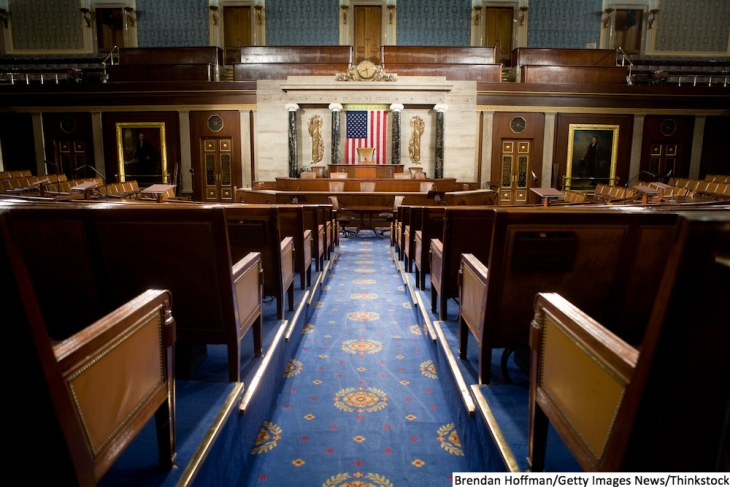The dominant narrative about the Every Student Succeeds Act (ESSA) is that it shifts authority over schools back to state governments. But this belies a key feature of the legislation. Indeed, my biggest complaint about ESSA is that it leapfrogs the state government in important places, creating an unwelcome federal government-school district relationship.
My objections are both legal and practical.
Excepting for issues involving federally protected rights (such as discrimination), state governments are ultimately responsible for K-12. This is a matter of the Tenth Amendment’s reserved powers and its education-related case law, like San Antonio v. Rodriguez.
It’s also explicit in state constitutions, which give state governments authority over primary and secondary schooling and place them squarely on the hook for delivering results. This is why, when plaintiffs sue over school funding or tenure rules, state governments—not districts—are the defendants. It’s also clear from state statutes. State laws create school districts and delegate power to them. State governments can decommission districts, consolidate them, take control of them, create new ones, or authorize other entities to deliver or oversee K-12 education.
When a federal education law does an end-run around the state to establish a DC-district link, it undercuts the state’s position and confuses lines of responsibility.
But as a practical matter, by directly empowering districts (a.k.a. LEAs) at the expense of the state, the federal government cements an antiquated understanding of K-12 delivery and oversight. Through chartering, vouchers, tax credits, ESAs, online learning, course choice, dual enrollment, CTE programs, state-run schools, and much more, state governments have moved far past 1965-era arrangements for K-12. It’s simply no longer the case that LEAs own, operate, and oversee all schools participating in the public education system.
Moreover, it is emphatically not the case that traditional districts are the right solution for all of our most pressing problems, such as persistently failing urban schools. Dysfunctional schools are generally a function of dysfunctional districts.
Lastly, in most big cities today, the state government—not the district—provides the lion’s share of school funding. So the state has a financial claim, beyond its legal claim, to exert influence over critical K-12 decisions.
Unfortunately, in too many places, ESSA defers to the district instead of the state. This muddies authority, undermines good governance, and has the potential to inhibit state experimentation and slow emerging state innovations.
Here are three quick examples.
First, per all of the above, states should be responsible for addressing failing schools and meeting the needs of kids assigned to them. But in Sec. 1003, School Improvement (the program replacing SIG), states must allocate at least 95 percent of these reserved funds to districts. If states want to be directly involved in these activities, they must obtain “the approval of the local education agency.”
A “rule of construction” in the legislation explains that states can allocate these funds to statewide districts (like the RSD) or consortia of districts so long as these are legally established as LEAs. But many encouraging state initiatives don’t run through LEAs. For example, many charter authorizers are not LEAs nor are many service providers. ESSA could have simply said, “States have authority to determine how to allocate these funds in order to assist students in schools identified for improvement.”
Second, under Sec. 1003A, Direct Student Services, the state must distribute funds directly to districts. Importantly, it must prioritize awards to districts with the most failing schools. It would, however, be completely reasonable for a state to decide that a district operating failing schools should not be the recipient, much less the director, of funds being allocated for kids assigned to failing schools. Nevertheless, the SEA, an SEA-identified service provider, a charter authorizer, or any other non-LEA would not be eligible.
Third, in the sections requiring interventions for struggling schools, districts are empowered to “locally develop and implement comprehensive support and improvement plans.” In instances requiring “targeted support,” each school identified for improvement is empowered to “develop and implement a school-level targeted support and improvement plan.” The state’s role is to “provide technical assistance” to these districts or schools. Only in instances of persistent failure is further state activity authorized.
From an operational standpoint, state education leaders shouldn’t need to wonder whether a federal statute empowers a creature of state law (the district) over the state itself. This is not an idle concern: ESSA dramatically constrains the Secretary of Education’s regulatory and guidance authority (an issue I’ll consider in a follow-up post), so expect emboldened districts to use these exact provisions to resist state action (all the way to the courts).
But from a policy and philosophical standpoint, Congress unnecessarily weighed in on a decision that should be left to state governments: how each state’s system of schools should be arranged and managed. In key areas, Congress took the side of LEAs when it should have simply allowed state governments to decide which authorities should remain at the state level and which should be delegated to other entities, including but not limited to districts.
By making these calls itself rather than handing them off to the states, the federal government—ironic, for legislation seen as relinquishing authority—appropriated a great deal of power.

